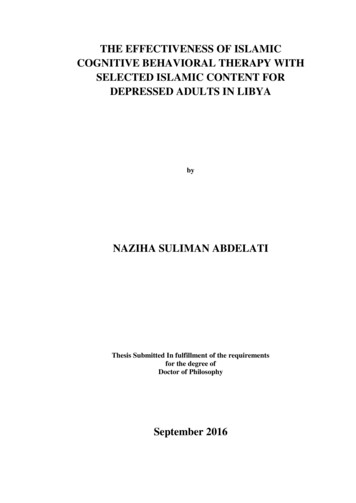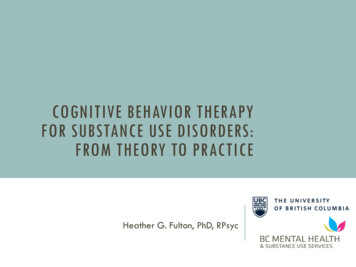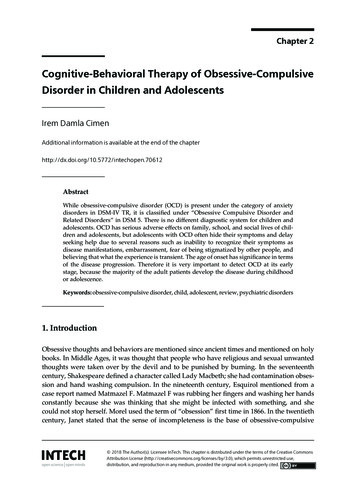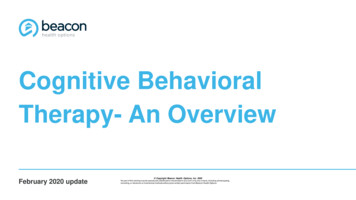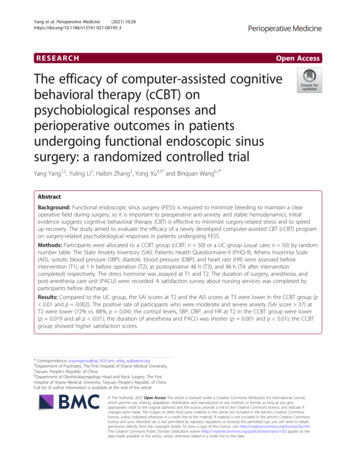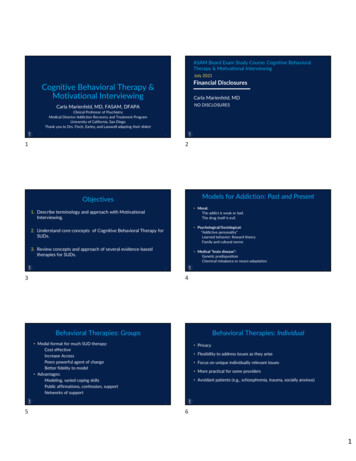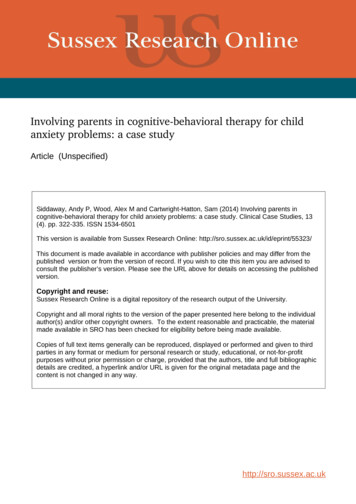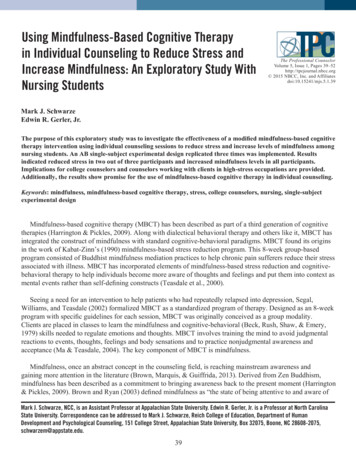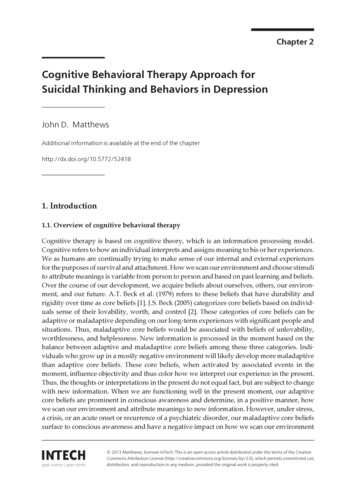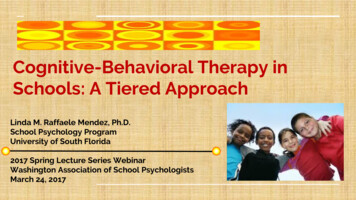
Transcription
Cognitive-Behavioral Therapy inSchools: A Tiered ApproachLinda M. Raffaele Mendez, Ph.D.School Psychology ProgramUniversity of South Florida2017 Spring Lecture Series WebinarWashington Association of School PsychologistsMarch 24, 2017
AgendaA Tiered Approach to School-Based Mental HealthCognitive-Behavioral Therapy: The Big PictureSocial-Emotional Learning at Tier 1Group Based Interventions at Tier 2Individualized Interventions at Tier 3
Addressing Mental HealthThrough a Tiered ModelContinuum of student supports
Tiered Models for:BehaviorMental HealthTier 1: SWPBISTier 1: Social-EmotionalLearning (SEL)Tier 2: Check In/Check Out,behavioral contracting,social skills groupsTier 2: Group-based CBTTier 3: FBA/BIPTier 3: Individual CBT
Cognitive ModelTeacher tellsstudent to stoptalking and starthis work.Studentthinks: “Shealways pickson me. Lotsof other kidsare talking,too!Focus ofcognitive therapyStudentfeels:Anger (7on a scalefrom 1-10)Focus ofbehaviortherapyStudent says: “What?! Whyare you picking on me?Don’t you see that Riley istalking, too? Why don’t yousay something to him?
Automatic Thoughts and Core Beliefs
Core Beliefs and Mental Health DisordersMental HealthConcernExamples of Common Thought PatternsAnxietyThe world is full of danger. I must constantly be alert to dangerin order to protect myself and my loved ones.DepressionI am not as good, smart, capable, or loveable as other people.AggressionI have to show other people who’s boss. Backing down from afight is a sign of weakness.AngerOther people are incompetent idiots. They do things just toupset me.BorderlinepersonalityThe only way to get other people to understand how I feel is toact in extreme ways (e.g., cut myself, say I am going to killmyself).
https://feelinggood.com/
Books I Use to Train Students in CBT
Why CBT? Evidence-based for a wide variety of youth mental healthproblems Many manualized programs available for use Can be used in both group and individual formats Has been adapted for youth with special learning needs ASD—e.g., Reaven, Blakely-Smith, Nichols, & Hepburn (2011)
Disorders for Which CBT is anEmpirically-SupportedTreatmentProbably EfficaciousWell-EstablishedGeneralized AnxietyDepressionODD/CDPTSDSocial PhobiaSubstance AbuseSelf-HarmOCDwww.effectivechildtherapy.org
CBT: Cognitive vs. Behavioral ComponentsCognitive Components Use of thought records Guided discovery using Socraticdialogues Collaborative problem-solving Use of metaphors and humor Psychoeducation regardingcognitive distortions Coping cardsBehavioral Components Behavioral experiments Exposures based on a fearhierarchy Pleasant events scheduling Examination of antecedents,behaviors, and consequences Shaping (successiveapproximations) Role playing (therapist modeling) Relaxation training
CBT within a Tiered ModelTier 1: Social-Emotional Learning (SEL) for all (with progressmonitoring to determine who needs additional supports)Tier 2: Group-based CBT interventions (with progress monitoring todetermine movement up or down within tiers)Tier 3: Individual CBT interventions (with progress monitoring todetermine movement up or down within tiers)Consultation with parents and school staff at each levelRaffaele Mendez (2017)
Tier 1 (Universal SEL): An Overview Start with a population-based needs assessment Identify an SEL program Train teachers to implement the program Monitor student progress Individual students The school as a whole
Population-Based Needs AssessmentPurpose: Develop an understanding of the social and emotionalstrengths and needs of the students at your schoolGoals: Answer questions such as:a. What is known about the mental health of students at the schoolor in the district?b. How would the needs of the population as a whole bedescribed?c. What are the needs of students in this population who are at-riskor showing early signs of mental health concerns?(Doll, Cummings, & Chapla, 2014)
Steps in the Needs Assessment1. Pre-assessment. A team of committed key stakeholders isformed, and a plan, method, and participants for theassessment are developed2. Assessment. Data is collected and analyzed (this mayinclude interviews, questionnaires/ surveys, communityforums, or focus groups)3. Post-assessment. A report is disseminated to theappropriate audiences, priorities are established, solutionsbased on the needs assessment are implemented, andthese solutions are monitored and evaluated(Nagle & Glover Gagnon, 2014)
Important Issues in Screeningand Implementation1. Parental consent for universal screeningFor what types of assessments do you need parental consent?2. Key indicatorsODRs, suspensions, rates of absenteeism, visits to the nurse’s office3. Systems-level issuesBuy in, support for the initiative4. Developing a long-term planWhat is needed to make the plan sustainable?5. Training and supporting teachers
Web-Based ResourcesCenter for School-Based Mental Health at theUniversity of MarylandSCHOOLMENTALHEALTH.orgSubstance Abuse and Mental Health ServicesAdministration (SAMHSA)SAMHSA.orgInstitute of Education Sciences’ What WorksClearinghouseIES.ED.gov/ncee/wwcDivision 53 of the American PsychologicalAssociationEFFECTIVECHILDTHERAPY.com
Empirically-Supported Universal SELProgramsI Can Problem Solve (Raising a Thinking Child)MindUP CurriculumPromoting Alternative Thinking Strategies (PATHS)PATHS to PAXPositive ActionProject ACHIEVESecond StepSkillstreamingStrong KidsThe Incredible Years
Tools for Universal Progress MonitoringSocial Emotional Health Survey System (SEHS)Behavioral and Emotional Screening System (BESS)Strengths and Difficulties Questionnaire (SDQ)Social Emotional Asset and Resilience Scale (SEARS)Systematic Screening for Behavior Disorders (SSBD)Social Skills Improvement System-Performance ScreeningGuide (SSIS-PSG)School Archival Records Search (SARS)Strong Kids assessment tools(Furlong, You, Renshaw, Smith, and O’Malley, 2014;; Kamphaus & Reynolds, 200; Goodman, 1997; Goodman, Meltzer, Bailey, 1998; Goodman, Lamping, Ploubidis,2010; Merrell, Felver-Grant, and Tom, 2011; Walker & Severson, 1992; Elliott & Gresham, 2008; Walker, Block-Pedego, Todis, & Severson, 1991; Merrell, 2007)
Tier 2 (Targeted Interventions):An Overview Identifying youth for Tier 2 servicesUniversal screeningSelf, family, or peer referralProgress monitoring Common types of interventions at Tier 2AnxietyDepressionAnger management trainingSocial skillsTrauma-focused
Examining School Level Data: AnExample from Syracuse City SchoolDistrict Screening/intervention protocol for moving from Tier 1to Tier 2Three to five ODRsLess than 90% attendanceAt-risk referrals from faculty or staff Screening intervention protocol for moving Tier 2 toTier 3Six or more ODRsPutnam (2013)
Common Types of Interventions at Tier 2Anger Management TrainingSocial SkillsCoping with AnxietyCoping with DepressionRecovery from Trauma
Tier 3 (Selective Interventions):An Overview Youth who should be triaged to Tier 3 Who is a good candidate for individual CBT? Other options if the student is not a good candidate forCBT Individual CBT for students with externalizing behaviors
Youth Who Should Be Triaged to Tier 3 EBDHomelessTwo or more suspensions in the past yearInvolved with the juvenile justice system or who havebeen incarceratedRefugeesFoster care systemExperienced two or more school changes in the past yearExperienced more than 10 absences in the past year
Is the Student a Good Candidatefor Individual CBT?1. Will the parent give consent for therapy?2. Does the student have the cognitive and language skillsneeded to benefit from talk therapy?3. Is the student able to generalize what is learned intherapy to everyday life?4. Is the student open to discussing problems with you?5. Is the student motivated to engage in personal change toreach goals?
Other Options at Tier 31. Behavioral interventions2. Teacher/parent consultationa. Family Check Up3. Community-based counseling4. Adult or peer mentoring
Individual vs. Group-Based CBTIndividual More flexibility toaddress individualissues of concern More privacyGroupOpportunities for: Practicing skills in agroup setting Learning from groupmembers
Tier 3: Constructing the TreatmentPlanWe typically choose 4-5 goals to work on based on the case conceptualization.These goals guide what we do in therapy each week.Goals are typically related to: Changing dysfunctional ways of thinking Alleviating painful emotions and/or associated physiological symptoms Learning problem-solving skills Changing dysfunctional behaviorsLet’s examine the case conceptualization and treatment plan for a high schoolstudent named Aja.
Tier 3 Case Conceptualization: AjaBullied by peers inmiddle school for beingdifferent; now anxiousabout social situations;On-going parentalrejection.Early diagnosis ofADHD; parentalalcoholism; sexuallymolested at age 7;repeated 6th grade;divorce of father andstepmother at age 13and subsequentmove to FL.Lowermiddle classfamily;familyattitudetowardproblems:“Get overit.”Sensitive;artistic; kind;bright andcreative;Salientcognitions: “I’monly worthsomething if Ihave aboyfriend.” “Iam inferior toother people.”Presenting ProblemsCognitive: Self-perceptions of worthlessness, inferiority; perceives that no one is therefor her.Emotional: Depression and social anxiety.Behavioral: Anhedonia, avoidance of opportunities to make new friends; beginning touse alcohol and marijuana to cope.Physiological: Limited energy; sweaty palms and racing heart in novel social situations.Interpersonal: Conflict-ridden relationship with parents; few friends; tends to cling toboyfriend when in a relationship.
Treatment Goals for Aja: Depression1. Improve mood. Increase positive self-talk (thought record, Socratic dialogue) Participate in activities previously found enjoyable (activity scheduling and monitoring)2. Decrease feelings of ineffectiveness and negative self-esteem. Identify errors in thinking and challenge cognitive distortions (thought record, didacticteaching, Socratic dialogue) Replace maladaptive thought patterns with realistic, adaptive thoughts (Socratic dialogue) Increase positive relationships with family (behavioral experiments, role playing, copingcards)3. Decrease risky behavior/maladaptive coping skills. Increase adaptive coping skills (didactic teaching) Decrease desire to engage in risky behaviors (Socratic dialogue)
Treatment Goals for Aja: SocialAnxiety4. Decrease fear of social situations.Identify errors in thinking and challenge thought distortions related to socialsituations (Socratic dialogue)Replace maladaptive thought patterns with realistic, adaptive thoughts (thoughtrecord, Socratic dialogue)5. Increase social confidence.Develop feelings of confidence in social situations (Socratic dialogue)Increase positive peer interactions (role playing, activity scheduling andmonitoring)
Session StructureCentral components:Mood check-in(Homework review)—2nd session and beyondAgenda settingStudent (and therapist) add items to the agendaProcessing through the session contentHomework assignmentEliciting client feedbackFriedberg & McClure (2002)
6 Therapeutic Techniques Used with AjaThought record--Use to help the student understand how perceptions (thoughts) lead to feelingsand behaviorsSocratic dialogue--Use when maladaptive thinking is leading to maladaptive feelings and behaviorActivity scheduling (and monitoring)—Use when a student needs to re-engage in activities topromote recoveryCoping cards--Use when the student needs to be reminded of adaptive ways of thinking in difficultsituationsBehavioral experiments--Use to help the student see how changes in his/her behavior can lead tochanges in others’ behaviorRole-playing (therapist modeling)--Use when a student does not know how to approach a situationadaptivelyDidactic teaching-Use to teach skills like adaptive coping, social skills, and relaxation strategies
Thought RecordUsed to help the student see the connection betweenthoughts, feelings, and behaviorsSituationThoughtFeeling (Strength)BehaviorYour motherforbid you to goout with a newboy who is mucholder than youwhom you reallylike.“My mother doesn’twant me to have alife.”Angry (8)Called your mother a b*tch andslammed your bedroom door in herface.You sat at adifferent table atlunch with a newfriend.“Why am I doing thisto myself? No one atthis table is going towant to talk to me!”Nervous, sad (7)Told your friend that you were feelingsick and spent the rest of the lunchperiod in the bathroom.
Types of Socratic Dialogue What’s the evidence? What’s an alternative explanation? What are the advantages and disadvantages? Decatastrophizing How can I problem solve?Friedberg & McClure (2015)
Socratic Dialogue: What’s theEvidence?Use this type of dialogue when you think that a studenthas jumped to conclusions without enough evidence.What to Do You help the student to examine the evidence that theautomatic thought is correct. Is the student’s evidence conclusive? Would other people draw the same conclusions from theevidence provided?
Socratic Dialogue: What’s anAlternative Explanation?Use this when you think the student has overlooked other possible waysof looking at the problem.What to Do Point out that there may be other ways of conceptualizing the problem. Does everyone think like you do? How might other people think aboutthis? Suggest (using humor if appropriate) other possible ways to look at thesituation.
What Are the Advantages andDisadvantages?Use this when a student’s thinking may be correctbut is not particularly helpful.What to Do Ask about whether the student’s way of thinking isassociated with particular advantages or disadvantages. Does this way of thinking lead you to want to try harder orgive up? Does this way of thinking make things better for you?
DecatastophizingHelping a student understand that a feared (dreaded) situation is unlikelyto happen.What to Do Point out that it sounds like the student is catastrophizing (snowballing) and providea definition of this type of distortion. Help the student generate other possibilities for outcomes. Ask about the likelihood that the feared outcome will actually happen. Help the student generate ways of responding/coping in the event that the fearedoutcome does occur.
Socratic Dialogue: How Can I ProblemSolve?Use this type of dialogue when you don’t perceivedistortions in how the student is thinking.Steps to Follow Have the student generate alternatives for how to addressthe problem Evaluate these options Choose a plan Assign the plan for homework
Role Play with AjaAs you watch the role play, note which type ofSocratic dialogue I am using.
Coping Card ExampleMy past does not define me. I am my own person, and myfuture is full of possibility. I can choose to write my ownstory and walk my own path. Aja
Behavioral ExperimentsExperiments designed to test the accuracy of a person’sthinking. With Aja, we used them to:(1) See how changes in Aja’s behavior would impact herrelationship with her parents.(2) See how her boyfriend would respond if she told him thatshe wanted to wait to become sexually active
Didactic TeachingUsed to teach skills. With Aja, we used:1. Controlled breathing2. Adaptive coping3. Social and hereditary factors in alcohol addiction
ReferencesBeck, J. (2011). Cognitive therapy: Basics and beyond—Second edition. Guilford Press: New York.Creed, T. A., Reisweber, J., & Beck, A. T. (2011). Cognitive therapy for adolescents in school settings. GuilfordPress: New York.Friedberg, R. D., & McClure, J. M. (2015). Clinical practice of cognitive therapy with children and adolescents:The nuts and bolts. Guilford Press: New York.Nagle, R.J., & Glover Gagnon, S. (2014). Best practices in designing and conducting needs assessment. In P.L.Harrison & A. Thomas (Eds.), Best Practices in School Psychology: Foundations (pp. 315-327). Bethesda, MD:NASP Publications.Putnam, B. (2013, November). Integrating mental health services across the tiers: Interconnected systemsframework system. Paper presented at the New England PBIS Forum, Norwood, MA.7Raffaele Mendez, L. M. (2017). Cognitive-behavioral therapy in schools: A tiered approach to youth mental healthservices. New York, NY: Routledge.Reaven, J., Blakeley-Smith, A., Nichols, S., & Hepburn, S. (2011). Facing your fears: group therapy for managinganxiety in children with high-functioning autism spectrum disorders. Baltimore, MD: Brookes.
Thank You For Your Participation!Questions/Comments:Linda M. Raffaele Mendezraffaele@usf.edu913-974-1255
CBT: Cognitive vs. Behavioral Components Cognitive Components Use of thought records Guided discovery using Socratic dialogues Collaborative problem-solving Use of metaphors and humor Psychoeducation regarding cognitive distortions Coping cards Behavioral Components Behavioral experiments Exposures based on a fear hierarchy
